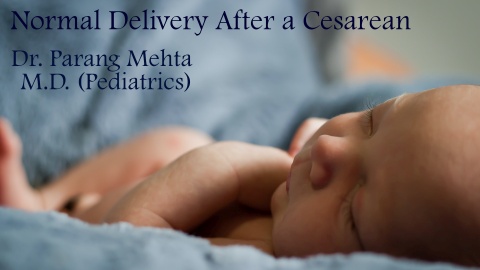Delivering Normally After
a Cesarean
If you delivered a baby by cesarean section some years ago, is a second operation mandatory this time also? Can you have a normal delivery after an earlier C-section?
Vaginal Birth After a Cesarean (VBAC) is a much discussed and studied subject in obstetrics. We now know that it is not only fairly safe, but also highly desirable.
A Cesarean Is Forever?
Earlier, we believed that "once a cesarean, always a cesarean." Normal delivery was considered very risky if a women had had a cesarean section. The wall of the uterus would be weak after the incision, so the reasoning went. The tremendous strain of a normal delivery would cause the weakened wall to give way, leading to a catastrophe.
However, we now know that women who have had a cesarean can still have the next baby normally (vaginally). The risks are a little higher than in a second normal delivery, but in a good obstetric unit, a trial of normal delivery should not be very risky for mother or child.
Why Not Another Cesarean?
No surgery should be undertaken without good and sufficient cause. A cesarean is a major operation. There should be a good reason for subjecting a woman to it, and a previous cesarean does not seem to be enough of a good reason.
A normal delivery is - well, normal. It is natural, physiological. Women recover quickly after it, are up and about in a few days, and can feed and look after baby sooner. A cesarean section needs prolonged bed rest, a long recovery time, and a longer delay before baby can be managed without aid.
Who Should Try VBAC?
A trial of normal delivery is not appropriate for all women who have had a cesarean earlier. Careful selection is essential to reduce the risks associated with VBAC. The following are favourable for a trial of normal delivery:
- A previous low transverse cesarean section.
- A singleton fetus. Multiple pregnancies (twins, triplets, and so on) may not be good candidates for VBAC.
- Vertex presentation - that's the normal head first position of the baby. Breech and other situations are unfavourable for VBAC.
- No other contraindications to a trial of labor.
The following conditions are not compatible with VBAC:
- Previous classic cesarean section. The vertical cut in the uterus is believed to give a weaker scar.
- Other surgery on the uterus, e.g. for fibroids.
- Previous uterine rupture.
- Maternal conditions like Placenta Previa.
- Fetal medical conditions like open neural tube defect.
Risks of VBAC
The main risk is of uterine rupture - the wall of the uterus giving way, because it has been weakened by the earlier cesarean section. Uterine rupture was a major fear in the past, when the baby was delivered by a vertical cut in the upper part of the uterus. This gave a weak scar, which often gave way when a normal delivery was tried later. This can be very serious, and even fatal, for the baby, mother, or both.
These days, however, a C-section is done with a transverse incision in the lower part of the uterus (hence the term lower segment cesarean section, or LSCS). This gives a much stronger scar, and uterine rupture now occurs rarely (about 5 times per 1000 deliveries). In a well equipped and staffed hospital, uterine rupture can be detected early, and serious consequences avoided.
Requirements of VBAC
The most important is good monitoring. The increased risk of this type of delivery mandates very careful monitoring of the mother to be and the unborn baby. There should be frequent listening to the baby's heartbeat, or continuous electronic fetal monitoring.
Another important requirement is the immediate availability of a cesarean section. There should be an operation theater close by, and a competent team to perform the surgical delivery.
Reasons to Abandon VBAC
Trials of normal delivery after a previous cesarean delivery have a success rate of 60-80%. However, in some situations, the trial has to be abandoned, and a cesarean section done.
- Failure to progress.
- Fetal distress.
- Maternal complications.
- Uterine rupture.
This is the group at highest risk of complications - women in whom a trial of labour is unsuccessful, and who then require a cesarean.
Last Revision: July 17, 2020
Would you prefer watching a video instead?
On our Youtube Channel

About the author
More About Babies
The Apgar Score
Breastfeeding-1
Breastfeeding-2
Bathing Your Baby
The Crying Baby
Danger Signs in Babies
Diabetes with Pregnancy
Baby's First Day
Infantile Colic
Going Home
Jaundice in Babies
Jaundice in Babies - Treatment
Massage
Normal Delivery After a Cesarean
The Premature Baby
Sleep
Teething
Full list of articles at bottom of page
Contact Information
Dr. Parang Mehta,
Mehta Childcare,
Opposite Putli, Sagrampura,
Surat.
Tel: +91 9429486624.
Email:
